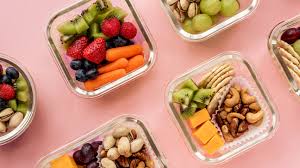Maintaining a healthy diet doesn’t have to stop when you leave home. With a bit of planning and a basic understanding of balanced nutrition, you can nourish your body even on your busiest days—whether you’re rushing to work, navigating a road trip, or enjoying a night out at a restaurant.

This guide explores how to make healthy eating choices on the go by focusing on essential food groups and real-life strategies that are easy to implement, no matter where life takes you.
Understanding the Foundations of a Balanced Diet
Eating well means incorporating a variety of nutrient-dense foods from all major food groups. Each group offers specific health benefits, and combining them ensures you’re getting a broad range of vitamins, minerals, and other nutrients your body needs to function at its best.
Here’s a breakdown of the five main food groups and examples from each:
-
Dairy: Milk, yogurt, cheese, lactose-free options, and fortified plant-based milks like soy milk.
-
Protein: Eggs, poultry, seafood, beans, lentils, tofu, nuts, seeds, and soy-based products.
-
Grains: Whole grains like brown rice, oats, quinoa, barley, and foods made from whole wheat.
-
Fruits: Fresh, frozen, canned (in 100% juice), dried fruits, and pure fruit juices.
-
Vegetables: Both starchy (like potatoes) and nonstarchy (like spinach, broccoli, and peppers), fresh, frozen, or canned without added salt.
Following USDA’s MyPlate guidance—based on the 2020–2025 Dietary Guidelines for Americans—can help structure your meals:
-
Fill half your plate with a mix of vegetables and fruits (focus on nonstarchy vegetables and whole fruits).
-
Use a quarter of your plate for lean protein.
-
Reserve the last quarter for whole grains.
-
Choose fat-free or low-fat dairy as a side or beverage.
To ensure nutrient diversity, pair at least two food groups in every meal or snack—for instance, combining fruit with yogurt, or hummus with whole-grain crackers.
Building a Nourishing Plate on the Go
Even when you’re not sitting down to a home-cooked meal, you can use a simplified version of MyPlate to build a healthy plate:
-
Half Plate: Load up on nonstarchy vegetables like leafy greens, cucumbers, bell peppers, or cauliflower.
-
Quarter Plate: Include a lean protein, such as grilled chicken, beans, eggs, or fish.
-
Quarter Plate: Choose a whole grain—quinoa, whole wheat pasta, or brown rice.
This visual guide can be applied whether you’re eating at a restaurant, packing a lunchbox, or assembling a plate at a buffet.
Satisfying, Nutritious Snacks for Busy Days
Snacks are more than just mini-meals—they’re an opportunity to stay energized between meals and prevent overeating later.
When choosing snacks, aim to pair a carbohydrate (like a whole grain) with a source of protein, fiber, or healthy fat. This combination slows digestion and keeps you feeling full longer. Examples include:
-
Apple slices with almond butter
-
Low-fat cheese with whole-grain crackers
-
Yogurt with berries
-
Trail mix with nuts and dried fruit
This mindful pairing approach also helps stabilize blood sugar and supports sustained energy.
Why Skipping Meals Can Be Counterproductive
It’s tempting to skip meals when your day gets hectic. However, this habit often backfires—leading to intense hunger, fatigue, poor focus, and overeating later on.
Skipping meals may also increase the likelihood of grabbing convenience foods high in sugar, salt, and unhealthy fats. Planning ahead and having accessible, pre-packed meals or snacks on hand can prevent this cycle and keep your nutrition on track.
Practical Tips for Healthy Eating in Common On-the-Go Scenarios
Here’s how to make healthy food choices during five common situations that often throw off even the best eaters:
1. When You’re Rushing Out the Door
Mornings can be chaotic, especially if you’re juggling kids, work, or an early appointment. But skipping breakfast can leave you running on empty.
Quick solutions:
-
Prepare overnight oats or yogurt parfaits the night before.
-
Keep hard-boiled eggs, fruit, and granola bars within reach.
-
Freeze homemade breakfast burritos for easy reheating.
Even grabbing a banana and a handful of almonds is better than nothing.
2. Eating at Restaurants
Dining out can be both a social treat and a challenge to healthy eating. But with a few mindful choices, you can enjoy restaurant meals without compromising your health goals.
Helpful strategies:
-
Look for grilled, baked, or steamed dishes rather than fried.
-
Ask for dressings and sauces on the side.
-
Replace fries with a side salad or steamed veggies.
-
Control portion sizes by splitting meals or saving half for later.
If the menu allows, customize your plate to follow the MyPlate ratio.
3. Social Events and Gatherings
Potlucks, holidays, and dinner parties often feature rich or indulgent foods. While these moments are meant to be enjoyed, balance is key.
Tips for staying on track:
-
Offer to bring a healthy dish so you have at least one nutritious option.
-
Fill your plate with vegetables and lean proteins before sampling richer fare.
-
Eat a small, balanced snack beforehand to avoid arriving overly hungry.
Remember, one meal doesn’t derail your progress—it’s the overall pattern that counts.
4. Traveling by Road or Air
Travel often leads to unpredictable meal times and limited healthy options. Convenience stores and airports aren’t known for nutritious food, so bringing your own snacks can be a game changer.
Smart travel snacks:
-
Nut butter packs and whole grain crackers
-
Trail mix with nuts, seeds, and dried fruit
-
Shelf-stable tuna or salmon packets
-
Protein bars with minimal added sugar
-
Dehydrated fruits or veggie chips
Also, stay hydrated—air travel and long car rides can dehydrate you more than you realize.
5. Managing Long Workdays or Errands
When you’re out for hours running errands or working through lunch, it’s easy to neglect your nutrition.
Plan ahead:
-
Pack a lunch and snacks the night before.
-
Store nonperishables like protein bars, mixed nuts, or jerky in your car or desk.
-
Set phone reminders to eat regularly to avoid hunger-driven decisions.
A little preparation keeps your energy up and your mind focused.
Choosing the Right Foods = Choosing the Right Containers
Investing in quality storage containers can make your on-the-go meals more convenient and safer to eat.
Recommended container types:
-
Airtight containers: Great for keeping snacks fresh and preventing spills.
-
Microwave-safe glassware: Ideal for reheating lunch at work or on the road.
-
Insulated lunch bags or coolers: Keeps perishables safe during long commutes.
-
Bento-style containers: Useful for portion control and separating food groups.
Labeling containers with prep dates can help track freshness and minimize waste.
Final Takeaway: Eating Well Doesn’t Have to Stop When Life Gets Busy
Making healthy food choices while away from home is absolutely achievable—with a little preparation and awareness.
Whether you’re eating at a restaurant, traveling, or just navigating a hectic day, focusing on nutrient-rich options from the five food groups—fruits, vegetables, whole grains, dairy, and protein—can help you stay on track.
Build meals with intention, combine food groups for snacks, and have convenient options ready to grab and go. The more consistently you plan ahead, the easier it becomes to maintain good nutrition no matter where your day takes you.


This was such a helpful read! I travel a lot for work, and it’s easy to fall into the fast food trap. These tips on portion control and reading menus more carefully were game changers for me.
Great article! I especially appreciated the part about packing healthy snacks. It’s such a simple habit that makes a big difference on road trips and airport layovers.
Looking forward to more like this!